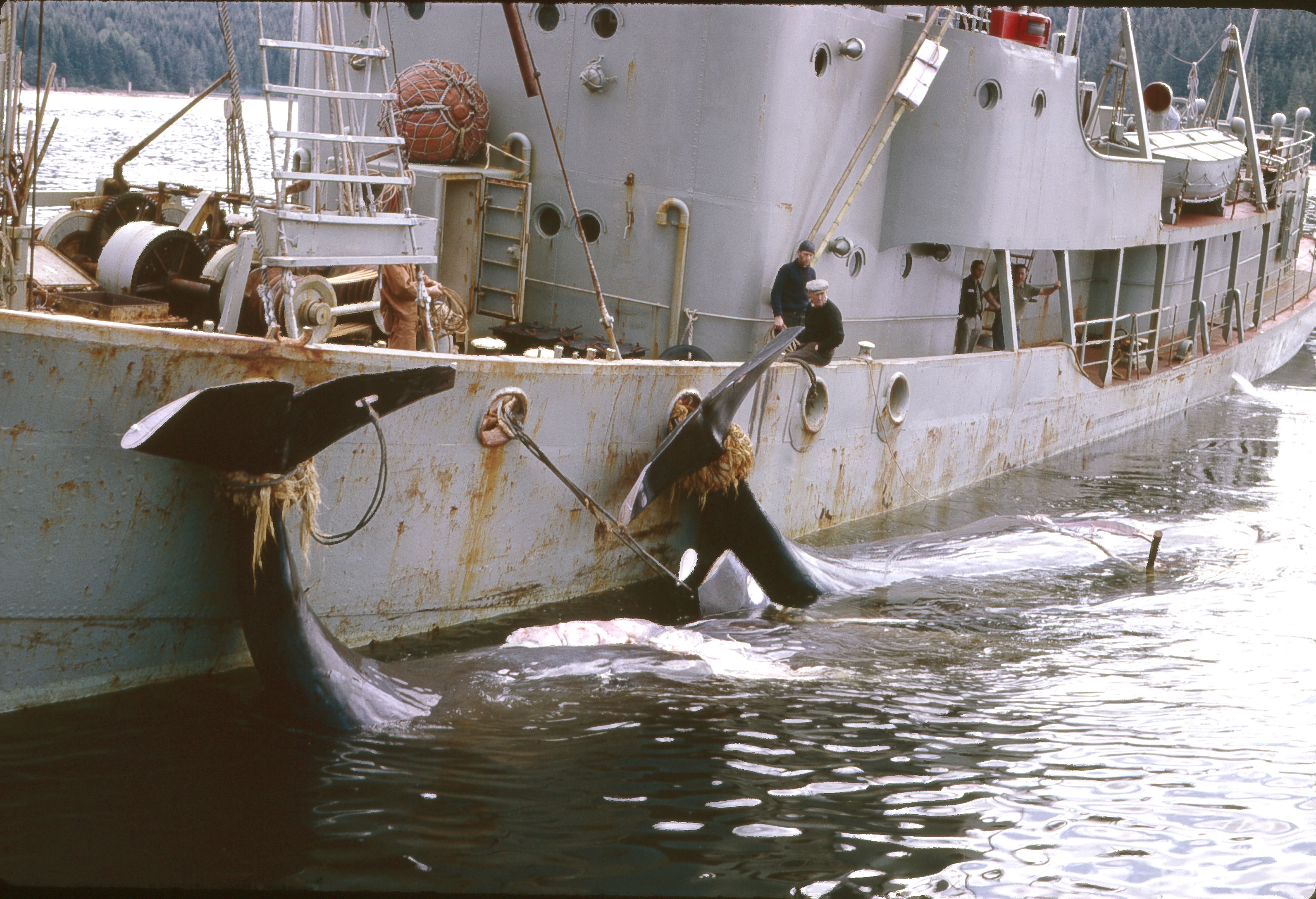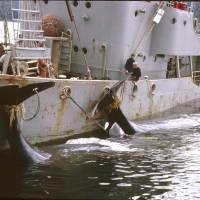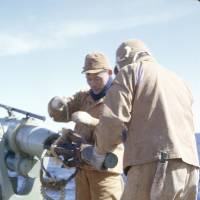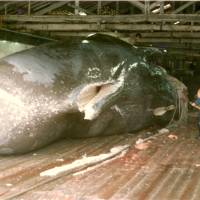The Japanese whaling fleet — this year just a factory ship, three catchers and what is being called a "surveillance" vessel — left Shimonoseki in Yamaguchi Prefecture in secret on Dec. 9, 2013 bound for the Southern Ocean and its annual hunt that will keep it away from home through March.
The fleet sails under the aegis of Kyodo Senpaku Kaisha, a company formed in 1987 when six whaling firms that merged into the Nihon Kyodo Hogei in 1976 amalgamated with the Japan Whaling Association and the Institute of Cetacean Research to create the modern Institute of Cetacean Research — which operates under the wing of the government's Fisheries Agency.
KSK is responsible mainly for the hunting of the whales, then the processing and marketing of whale products. It is heavily funded by the Japanese government.
In this current Antarctic "research whaling" season, the supposed aim is to take 935 Minke whales, 50 Fin whales and 50 Humpback whales. They won't get anywhere near that number, and the proposal to kill Fin whales — next in size to the great Blue whales, and generally considered to be endangered — as well as Humpback whales — those breaching, splashing, serenading darlings of the whale-watching trade — is both ludicrous and quite unnecessary for cetacean research, which nowadays can be conducted just as well by non-lethal means.
But the slaughter is also, of course, a red rag to conservationists the world over, including in Japan.
The nonprofit Sea Shepherd Conservation Society, founded in the U.S. state of Washington in 1977, has started its 10th annual Antarctic campaign against Japan's whalers, sending three vessels, one carrying a helicopter, to interfere with the hunt and harass the ships. Their methods are confrontational, aggressive and reckless.In February 2013, the U.S. Ninth Circuit Court of Appeals labeled Sea Shepherd as "pirates" and issued an injunction against their vessels sailing within 500 yards (457 meters) of the Japanese fleet.
In Australia, and in much of the rest of the world, however, Sea Shepherd is viewed as heroic — though in Japan they are widely reviled. Personally, I regard their actions in the deadly waters of the Southern Ocean as being in violation of all the rules of seamanship — no matter what the motive. However, Sea Shepherd's tactics are undeniably effective. In the 2013 Antarctic whaling season, only 103 Minke whales were taken by the Japanese fleet.
The Tokyo government heavily funds this operation, and I believe Japanese Coast Guard officers sail with the fleet — though I doubt this year's mysterious "surveillance vessel" is a Coast Guard ship, but merely a catcher with the harpoon gun removed. However, having wasted half a day trying to discover what exactly it is, and what its role is meant to be, I gave up in favor of my editor's deadline.
The bombastic rhetoric coming from Sea Shepherd and their supporters reads like something concocted by North Korean propagandists. The Japanese tend to be a bit more subdued, though a Sea Shepherd ship has been publicly branded a "terrorist vessel," and many here sense the issue is tinged with racism. Whatever, for the 10th year in a row, the whole sad, pointless pantomime is unfolding again.
I have a long relationship with whaling and whalers. I was only 17 when I first went to the Canadian Arctic as a researcher living and hunting with Inuit, and since then I've had nothing, in principal, against the taking of marine mammals for food, clothing and fuel as they do — whether whales, seals, walruses or whatever.
Then in 1965, after my first stopover in Japan, I returned to Canada as a marine mammals technician with the Fisheries Research Board — whose mandate included researching marine mammals in Atlantic coastal waters. I had hoped to be sent back into the Arctic, but instead I was assigned to cetacean research and sent for training to a whaling station called Coal Harbour at the northern end of Vancouver Island, British Columbia, to learn how to take samples and measurements from great whales. That kind of fieldwork was very different from taking data from seals, walruses and Beluga as I'd been used to.
Coal Harbour, which was a seaplane base during World War II, had been converted to a shore station for a joint Canadian-Japanese whaling venture. The domestic partner was B.C. Packers Ltd., while the Japanese side was the Taiyo Fisheries Co.
The five catchers based there hunted Sperm and Sei whales off the Pacific Coast, and were manned by both Canadian and Japanese crews. When the dead whales were brought in and dragged up a ramp onto a wooden decking to be butchered, the meat and blubber from the Sei whales was all processed and sent to Japan as human food, while the bones and entrails, and the blubber from the Sperm whales, was converted to oil and meal. Nothing was wasted.
The Japanese, especially the shore crews, were polite, efficient and extremely friendly once they found I could speak some of their language and loved sake and Japanese food — including whale sashimi.
Immediately after a month's training there, I was sent all the way across the country to Blandford, a small community on the Atlantic coast of Nova Scotia. There, Norwegian whalers, and a mixture of Norwegian and Canadian shore workers, had started a similar operation to Coal Harbour's, but hunting for Atlantic Fin whales.
However, standards there were far worse: It was wasteful, and lactating females and undersize young were often taken illegally — with the meat sold to farms where thousands of caged mink and foxes were raised for their fur. I protested long and loud about this — but all that happened was I was sent back to the Arctic the next year.
Then, in 1966, the Kyokuyo Whaling Co. started a joint Canadian-Japanese operation hunting Fin whales from a village further north in Newfoundland that gloried in the name of Dildo. This was totally different, and I was recalled from the Arctic to be the government observer there. As in British Columbia, in this Japanese-controled operation nothing was wasted and the meat and blubber were sent back to Japan as human food.
I have written a lot about this, and it was a very formative time for me as a young man. The Japanese, at least off the coasts of Canada, obeyed the rules of the International Whaling Commission, their seamanship was superb, and they were as friendly and as cooperative as could be.
Mind you, I did have doubts. The next year the Canadian government licensed a third shore-based whaling operation, further north again but still hunting the same stock of migrating Fin whales — with no quotas set. It just couldn't last.
My final whaling encounter was in 1980, after I spent a year researching a novel in Taiji, Wakayama Prefecture, a port now infamous for 2010's Oscar-winning documentary-feature film "The Cove," about the dolphin slaughters there. That time, I went to the Antarctic as a freelance observer with the Japanese whaling fleet.
Since 1986, following a vote by its members, the International Whaling Commission has had in place a moratorium on all commercial whaling in the Antarctic. However, the Japanese government at once homed in on small print allowing research whaling there, and forthwith licensed its own Southern Ocean program. Japanese catchers have been hunting whales there ever since, and selling meat and blubber for human consumption, However, there has been precious little research to show for it all as far as I know, and fewer and fewer Japanese eat whale nowadays — so frozen stocks continue to pile up at great expense in terms of refrigeration.
In the meantime, because of this, Japan's international image worsens each year, while Sea Shepherd gains more supporters, funding and media coverage.
As I have been saying publicly for quite some time now, I would like to see the killing of whales in the Southern Ocean surrounding Antarctic cease. It is not needed, either for research or to feed people in Japan, and — weighed against all the furore and worldwide fanfare of disgust — the money, effort and stubborn domestic media coverage that's involved in these futile expeditions does this country nothing but harm.
In fact, all the money and effort Japan's pointless hunts consume would be far better used for genuine Antarctic research — especially considering all the questions and concerns raised about changes in global weather patterns and threats to the entire marine environment.
Hence I sincerely urge that Japan continues with an active and dynamic marine research program in the Antarctic, preferably with international cooperation and input — but it does not have to be lethal for the whales, nor for seals or penguins, from which data and DNA samples can be collected by proven and harmless means.
However, if Japan chooses to insist that whaling culture and techniques need to be preserved, then I believe the correct course is through a transparent and internationally monitored coastal whaling program centered on traditional whaling communities such as Taiji, Ayukawa in Miyagi Prefecture and Abashiri on the Sea of Okhotsk in northern Hokkaido.
And should Sea Shepherd and their ilk want to flaunt their antics there, they'll find the Japanese Coast Guard is very well equipped to deal with them.





















With your current subscription plan you can comment on stories. However, before writing your first comment, please create a display name in the Profile section of your subscriber account page.